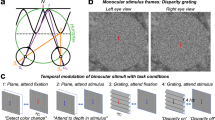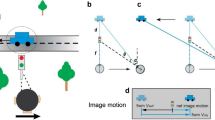Abstract
Visual cortical processing is segregated into pathways each consisting of several cortical areas. We identified key mechanisms of local competitive interaction, feedforward integration and modulatory feedback as common principles of integration and segregation of ambiguous information to implement a principle of evidence accumulation and feedback hypothesis testing and correction. In a previous work we demonstrated that a model of recurrent V1-MT interaction disambiguates motion estimates by filling-in. Here we show that identical mechanisms along the ventral V1-V2-V4 pathway are utilized for the interpretation of (1) stereoscopic disparity and (2) relative depth segregation of partially overlapping form. The results show that absolute and relative depth ambiguities are resolved by propagation of sparse depth cues. Lateral inhibition emerges at locations of unambiguous information and initiates the recurrent disambiguation process. Our simulations substantiate the proposed model with key mechanisms of integration and disambiguation in cortical form and motion processing.
Access this chapter
Tax calculation will be finalised at checkout
Purchases are for personal use only
Preview
Unable to display preview. Download preview PDF.
Similar content being viewed by others
References
Hupé, J.M., James, A.C., Girard, P., Lomber, S.G., Payne, B.R., Bullier, J.: Feedback connections act on the early part of the responses in monkey visual cortex. J. of Neurophys. 85, 134–145 (2001)
Friston, K.J., Büchel, C.: Attentional modulation of effective connectivity from V2 to V5/MT in humans. PNAS 97(13), 7591–7596 (2000)
Neumann, H., Sepp, W.: Recurrent V1–V2 interaction in early visual boundary processing. Biological Cybernetics 81, 425–444 (1999)
Neumann, H.: Completion phenomena in vision: A computational approach. In: Pessoa, L., DeWeerd, P. (eds.) Filling-In – From perceptual completion to cortical reorganization, pp. 151–173. Oxford Univ. Press, New York (2003)
Simoncelli, E.P., Heeger, D.J.: A model of neuronal responses in visual area MT. Vision Research 38, 743–761 (1998)
Grossberg, S.: How does a brain build a cognitive code? Psych. Review 87, 1–51 (1980)
Bayerl, P., Neumann, H.: complementary computations for motion binding, segregation and the neural solution to the aperture problem. Perception Supplement 32, 19–20 (2003)
Spratling, M.W., Johnson, M.H.: A feedback model of visual attention. J. of Cognitive Neuroscience 16(2), 219–237 (2004)
Bayerl, P., Neumann, H.: Disambiguating visual motion - a model of recurrent V1-MT interaction. In: Eighth International Conference on Cognitive and Neural Systems (ICCNS 2004), Boston, USA (2004) (in press)
Bayerl, P., Neumann, H.: Disambiguating visual motion by form-motion interaction - a computational model. In: Early Cognitive Vision Workshop (ECOVISION 2004), Isle of Skye, Scotland (2004), http://www.cn.stir.ac.uk/ecovision-ws/schedule.php
Pack, C.C., Born, R.T.: Temporal dynamics of a neural solution to the aperture problem in cortical area MT. Nature 409, 1040–1042 (2001)
Egnal, G., Wildes, R.P.: Detecting binocular half-occlusions: experimental comparisons of five approaches. Trans. on PAMI 24(8), 1127–1133 (2002)
Matthews, N., Meng, X., Xu, P., Qian, N.: A physiological theory of depth perception from vertical disparity. Vision Research 43, 85–99 (2003)
Zhou, H., Friedman, H.S., von der Heydt, R.: Coding of border ownership in monkey visual cortex. J. of Neuroscience 20(17), 6594–6611 (2000)
Hansen, T., Neumann, H.: Neural mechanisms for the robust detection of junctions. Neural Computation 16(4) (2004) (in print)
Thielscher, A., Neumann, H.: Determining the depth of 2D surface patches using local relative depth cues in a model of local recurrent interactions. In: 7th Tübingen Perception Conference (TWK 2004), Tübingen, Germany, pp. 166 (2004)
Adelson, E., Bergen, J.: Spatiotemporal energy models for the perception of motion. Optical Society of America A 2(2), 284–299 (1985)
Grossberg, S.: A neural theory of punishment and avoidance, II: Quantitative theory. Mathematical Biosciences 15, 253–285 (1972)
Blake, R., Wilson, H.R.: Neural models of stereoscopic vision. TINS 14(10), 445–452 (1991)
Marr, D., Poggio, T.: Cooperative computation of stereo disparity. Science 194, 283–287 (1976)
Author information
Authors and Affiliations
Editor information
Editors and Affiliations
Rights and permissions
Copyright information
© 2004 Springer-Verlag Berlin Heidelberg
About this paper
Cite this paper
Bayerl, P., Neumann, H. (2004). A Model of Motion, Stereo, and Monocular Depth Perception. In: Rasmussen, C.E., Bülthoff, H.H., Schölkopf, B., Giese, M.A. (eds) Pattern Recognition. DAGM 2004. Lecture Notes in Computer Science, vol 3175. Springer, Berlin, Heidelberg. https://doi.org/10.1007/978-3-540-28649-3_12
Download citation
DOI: https://doi.org/10.1007/978-3-540-28649-3_12
Publisher Name: Springer, Berlin, Heidelberg
Print ISBN: 978-3-540-22945-2
Online ISBN: 978-3-540-28649-3
eBook Packages: Springer Book Archive




